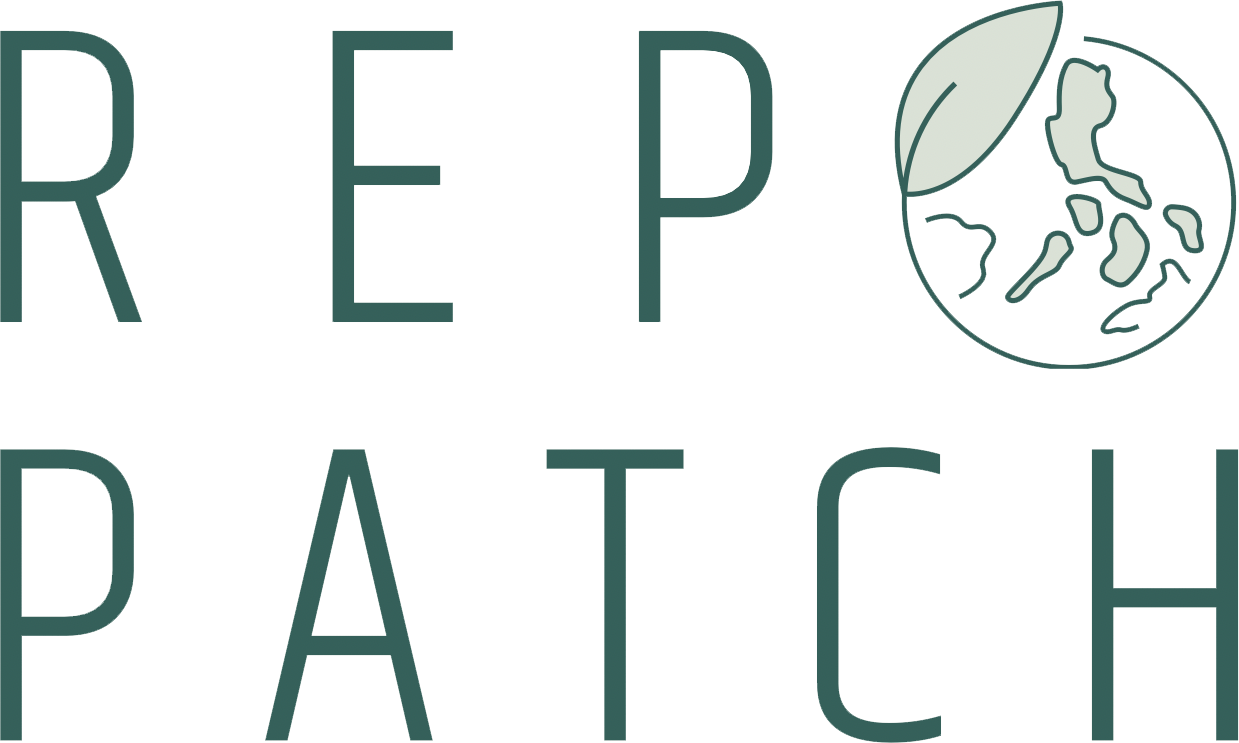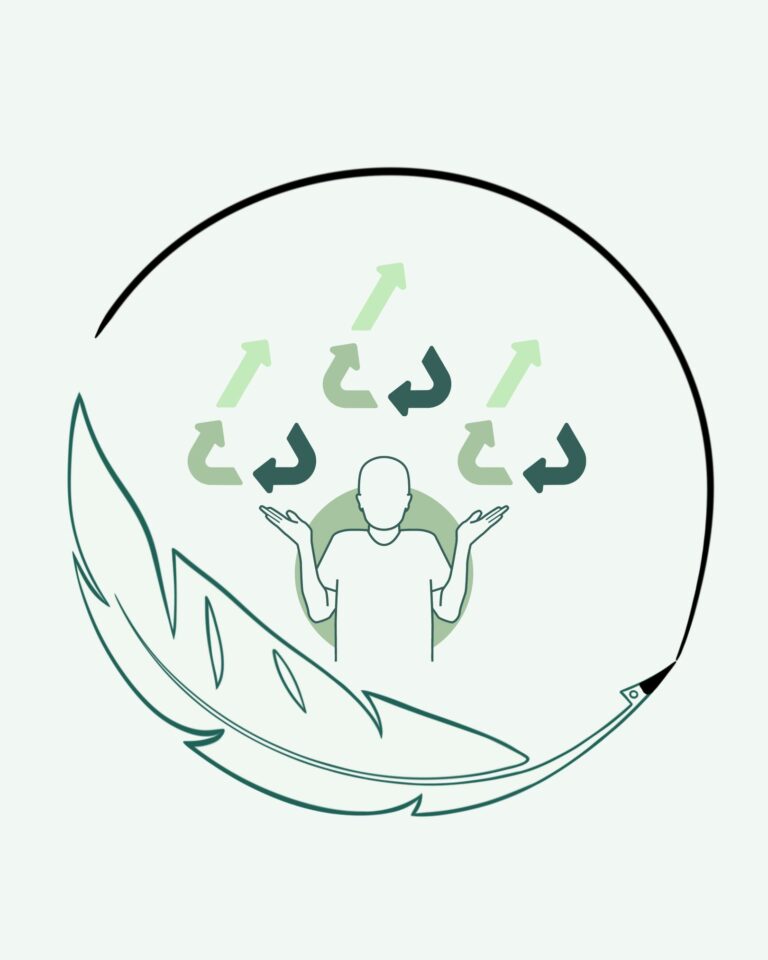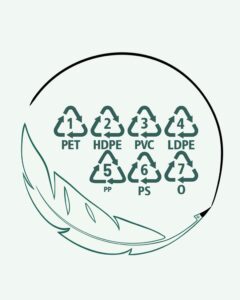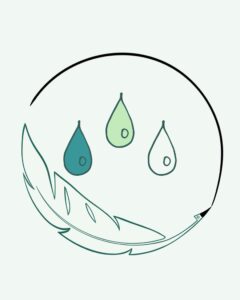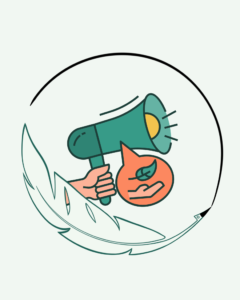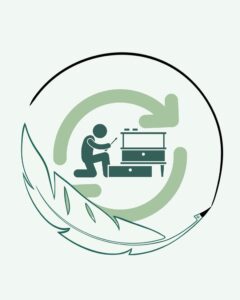What is Upcycling?
Upcycling; It covers the process of transforming products that are no longer unwanted or considered waste into new products of higher value or quality. The focus of upcycling is on sustainability and reducing waste. It focuses on creatively reusing materials or products to give waste a new purpose or function. Contrary to recycling, which is based on breaking down wastes into raw materials, upcycling; aims to re-evaluate existing items and add value through design.
The aim of upcycling is to find innovative ways to extend the life of materials or products that qualify as waste and end up in landfills, causing environmental degradation. These products can be materials such as plastic, textile, metal or glass waste. With upcycling, products can be given a new lifespan by reducing the demand for new resources and minimizing the environmental impact associated with production and disposal.
Upcycling can include a variety of materials, including furniture, clothing, electronics and household goods. Examples of upcycling projects are turning old wine bottles into decorative lamps, turning wooden pallets into outdoor furniture, or turning an old suitcase into a stylish storage solution. Upcycling promotes a more sustainable approach to consumption. These creation processes refer to innovation, design and skill.
The concept of upcycling has its roots in various historical practices. While the term “upcycling” is relatively modern, the idea of reusing materials has existed throughout human history. Here are some key milestones in the history of upcycling:
Frugality and Resourcefulness: Throughout history, people have demonstrated examples of upcycling by redesigning and re-evaluating their products for reasons such as scarcity or limited resources. We can see this particularly evident in times of war or economic distress, when supplies are scarce. For example, during World War II, people repurposed clothes and household items out of necessity. Again, due to the cessation of fabric production during the war, they made clothes from flour sacks and evaluated the sacks in line with their needs.
Build and Fix: This concept originated in the UK during World War II. the government encouraged citizens to repair and reuse clothes and household items, considering possible shortages and problems due to the war. Thus, the first steps of the ‘Build and Fix’ philosophy were taken. The philosophy of prolonging the life of items through repair and reuse became common practice at the time.
Arts and Crafts Movement: In the late 19th and early 20th centuries, the arts and crafts movement emerged as a response to industrialization. This movement emphasizes craftsmanship, handmade products, a return to traditional skills and the uniqueness of craftsmanship. It rejects mass production and supports the adoption of individual creativity. The production method, which is basically based on the philosophy of handcraft (slow production) and the uniqueness of the product, overlaps with the cornerstones of upcycling.
Environmental Awareness and Sustainability Movements: Parallel to the importance of environmental concerns in the second half of the 20th century, the idea of upcycling gained momentum. Focusing on reducing waste, conserving resources, and minimizing the negative environmental impact of consumption began to take hold. This idea has led to an increased interest in the reuse and evaluation of products.
Upcycling as a Contemporary Concept: The term upcycling began to gain popularity in the early 2000s. William McDonough and Michael Braungart’s book “Cradle to Cradle: Remaking the Way We Make Things” published in 2002 was an important factor in the spread of the term. The book introduced the idea of designing products based on the philosophy that materials are upcycled or reused at the end of their lifecycle.
Thus, upcycling has been widely accepted as a creative and sustainable practice. Upcycling has begun to be embraced by artists, designers and individuals seeking alternative ways to reduce waste and improve environmental awareness.
Today, upcycling is praised for its ability to transform discarded materials into aesthetically pleasing, unique and functionally useful objects. A key component of sustainable design continues to evolve as an expression of creativity and environmental responsibility.
What are the Differences Between Upcycling and Recycling?
In the framework of sustainability, both upcycling and recycling play important roles in reducing waste and promoting a circular economy. Although they share the common goal of minimizing environmental impact, upcycling and recycling are approaches with different processes and outcomes. In this blog post, we will explore the differences between upcycling and recycling, shedding light on the benefits of these processes and their contribution to sustainable living.
Defining Upcycling:
Upcycling is a creative process that transforms waste materials or unwanted products into products of higher value, quality or functionality and does this through design. It involves redesigning discarded materials, often through innovative design and craftsmanship. Upcycling gives new purpose to products that would normally go to landfills and extends their life cycle. Since all these processes take place on the basis of design, the quality increases and an aesthetic beauty emerges.
Understanding Recycling:
Recycling is a process that involves breaking down materials and converting products back into raw materials to produce new products. It is the process of converting waste materials into a reusable form by industrial techniques such as sorting, cleaning and reintroducing them into the production process. Recycling focuses on recovering waste, reducing the demand for unused materials and minimizing the energy and resources required for production. But recycling processes also need energy. In the recycling processes, which are based on breaking down the products and turning them into raw materials, the initial state of the product may lose value.
To give an example, we can think that nylon black bags used in daily life were once materials such as plastic bottles and various packaging wastes. Loss of value in these processes is a common situation. Recycled product may appear as a lower quality product than its original form.
Focus on Creativity and Design:
One of the main differences between upcycling and recycling is their approach to creativity. Upcycling processes emphasize artistic expression, craftsmanship and design. It focuses on the transformation of materials into new and distinctive products. It often contains creative elements that emphasize the originality and beauty of upcycled items. Recycling, on the other hand, prioritizes efficient material recovery. Both their priorities and transformation philosophies are different. Aesthetic concern and functionality are at the forefront in the forward transformation. This process focuses on increasing the quality of the product. Recycling is based on the principle of recycling into raw materials that can be reused.
Upcycling encompasses a material conversion in which the original product is reshaped, repurposed, or repaired and repurposed to create something new. In this process, the original product retains its character and results in a new product with increased value. We can observe the material, form and texture of the main product in new productions. Recycling, on the other hand, often involves breaking down materials into their basic components for remanufacturing. These processes may result in new products that do not resemble the original product.
Environmental Impact and Conservation of Resources:
Both upcycling and recycling serve the philosophy of contributing to the conservation of resources and the reduction of waste. However, upcycling can generally be said to have a more significant environmental impact, as it extends the life of products and reduces the need for new production. Upcycling makes products reusable, minimizing energy consumption, reducing carbon emissions and avoiding wasting valuable resources. Recycling needs energy and resources to collect, sort and process materials.
Consumer Participation and Mindful Consumption:
Upcycling encourages consumer engagement and mindful consumption. Consumers who appreciate the value and craftsmanship of upcycled products can become active participants in the sustainable design and slow fashion movement. This awareness is very important within the framework of sustainability. Upcycling supports local artisans and encourages individuals to make informed choices with their unique products. Recycling, although important, may not always involve the same level of consumer involvement.
Upcycling and recycling are two different approaches to the common goals of waste reduction and resource conservation. Upcycling breathes new life into discarded materials through design expression, emphasizing creativity, design and individuality. Recycling focuses on efficient material recovery and turning waste into raw materials to produce new products. The advantages of both approaches differ as we mentioned. Both transformations are part of the larger goal of achieving a sustainable future. By understanding the differences between upcycling and recycling, you can make informed choices and contribute to the journey towards the circular economy.

How is Upcycling Implemented?
Upcycling is a creative and versatile process that allows you to redesign and transform products in a variety of ways. Here are some general steps to guide you through upcycling:
Product selection: Select a product you want to upcycle. This item can be any material such as furniture, clothing, accessories, a wooden or glass item, or even a metal tin.
Evaluate the product: Examine the condition of the product and identify its conversion potential. Consider structural integrity, material properties, and any repairs that may be required.
Brainstorm: Let your creativity flow and quickly think of different ways to redesign the product. Then consider the current function of the product and determine how it can be transformed into something new and useful. While doing this, consider your needs. The product you transform can meet any of your needs. Research online, look for inspiration on social media platforms, and explore previous upcycling projects to gather ideas.
Plan your project: Once you’ve decided on your conversion idea, create a plan for your upcycling project. In this process, you can outline your design idea or make a list of related steps. Consider any tools, materials or additional materials you may need for the conversion.
Gather the necessary materials and tools: You can now gather the materials and tools needed to complete your upcycling project. At this point, we recommend using the materials you have at hand. materials; may include paints, brushes, glue, fabrics or other materials specific to your project.
Prepare and clean the item: This section is very important for upcycling processes. The materials we transform may be materials that we have not used before at home or that we have outsourced. Remove any dirt, dust or old polish that may affect the project. Before starting the conversion, thoroughly clean the product and prepare it for the upcycling process.
Implement your design: Start working on your upcycling project according to your plan. This process may involve painting, sanding, sewing, cutting or joining various components. Be creative and enjoy breathing new life into the product.
Add personal touches: Add unique touches in your own way to make the upcycled product truly yours and add something of your own. Use decorative elements, embellishments or additional features to enhance its visual quality.
Test and fix: After you complete the upconversion process, test the item to make sure it works as you intended. Make any necessary corrections or improvements to improve its usability or aesthetics.
Display and enjoy: proudly showcase your up-converted creativity, share and use it with people around you. Whether it’s a piece of furniture, a fashion accessory or a decorative item, let it serve its new purpose and make you feel the positive impact of upcycling.
Remember, upcycling is all about creativity and resourcefulness. Congratulate yourself for opening up new possibilities for wasteful products. Embrace the opportunity to try and explore new possibilities.
In this part of the blog, we’ll cover a few main upcycling techniques that can be used to upcycle and reuse products. These techniques can be associated with the craft.
Painting and Repair: Painting may be the most preferred technique for upcycling. It is an easy and fast process to apply. By completely changing the color and appearance of a product, you can give it a fresh and updated look. You can choose different paints such as acrylic, chalk paint or spray paint to transform furniture, decor items and even clothes. You can also use renovation techniques such as sanding, polishing or painting to restore and enhance the natural beauty of wood surfaces.
Repurpose and Reuse: It involves giving a new function or purpose to a product. For example, you can turn an old ladder into a bookcase, and glass bottles into vases or candle holders. Take a creative look at the existing product and consider how it could be used differently.
Fabric Upcycling: Fabric upcycling; It involves reusing textiles such as old clothes, unused curtains or sheets. You can cut and sew them into new products, accessories or home decorations. For example, you can turn old t-shirts into reusable shopping bags, jeans into stylish shorts, or you can create quilts with leftover fabrics using the traditional patchwork technique.
Upcycled Mosaic: A mosaic is a working model made by arranging small pieces of material such as broken tiles, glass or ceramics on a surface to create a design or pattern. You can use this technique to transform old tabletops, flower pots or mirrors. Mosaic adds color, texture, and visual interest to an item when reusing broken or unused materials.
Upholstery and Reupholstery: Upholstery techniques can be used to breathe new life into furniture pieces and change their design. Reupholstery involves removing the existing upholstery and replacing it with new fabric, giving the furniture a new and updated look. To make the process even more environmentally friendly, you can choose sustainable and environmentally friendly fabrics, and you can turn old upholstery fabrics into new products.
Lighting Upcycling: You can be upcycled by rearranging and replacing your lighting. In the process, take advantage of the materials you do not use in your home. For example, you can turn an old strainer into a pendant lamp, glass bottles into a lamp, or make a chandelier from discarded pieces such as cutlery.
These are just a few of the many upcycling techniques our partners are using. The key here is to think creatively, explore different materials and possibilities, and let your imagination guide you in giving new purpose and value to old items.
Let’s Explore Papier-mâché
A versatile and time-honored craft, this practice has been the focus of artists and creative disciplines for centuries. Derived from the French term meaning “chewed paper,” papier-mâché is based on turning dough into solid and moldable objects. In this part of the blog, we’ll be talking about the fascinating world of pulp, its rich history, and its technique to inspire your creativity.

Historical significance:
Papier mache has a multi-layered history that dates back to ancient Egypt and China. The technique, which gained popularity in Europe during the Renaissance, offers an affordable alternative to expensive materials for creating decorative objects. It has many uses, from intricate masks and theater props to elaborate figurines. It has quickly gained acceptance because it is an accessible art material.
Production Process:
The papier-mâché process includes several important steps. First, a pulp is formed by soaking the torn or shredded paper in water until it softens. It is mixed or crushed in a bowl to bring it to the desired consistency. Then, the dough is shaped on an armature or frame and the desired appearance is obtained. After the desired shape is obtained, the object is left to dry and harden. Finally, the surface can be painted, varnished or decorated as desired.
Creative Possibilities:
Papier-mâché offers a wide range of creative possibilities. Its moldability allows the creation of sculptures, masks, bowls, vases and even furniture. Artists can experiment with different techniques by layering paper and pulp to create strength and texture. The only limit is your imagination.
Educational and Entertainment Value:
Papier-mâché can be positioned as an excellent educational tool for both children and adults. It encourages creative thinking, develops skills and provides an opportunity to learn about the properties of materials. In addition, papier-mâché provides an ideal production process for individuals, families and community groups to bond while creating unique and personalized works of art.
Sustainability:
Papier-mâché complies with sustainable and environmentally friendly principles. Upcycled paper scraps provide a sustainable creation process while minimizing paper waste and providing environmental benefits. It serves a sustainable lifestyle.
Cultural and Artistic Expressions:
Papier-mâché occupies an important place in cultural celebrations and artistic expressions around the world. In many countries, pulp masks are an integral part of traditional festivals and ceremonies. Artists also push the boundaries of pulp design, incorporating it into mixed-media artworks, installations and even fashion design.
Papier-mâché is a testament to the transformative power of dough. Its rich history, versatility and creative potential continue to captivate artists and enthusiasts around the world. Sometimes a masterpiece takes shape, sometimes bizarre masks are made, sometimes it provides a training ground… Papier mache offers an accessible and eco-friendly environment to express your imagination and bring your artistic visions to life. So, gather your papers, prepare your dough and embark on a journey of creativity and self-expression through the art of papier-mâché. Don’t forget to visit our papier-mâché artists in our designer network!
Upcycling from Worldwide Brands
As the world becomes more and more important to the importance of sustainability, many famous brands have embraced the concept of upcycling. By designing and selling upcycled products, these companies contribute to the global movement to reduce waste and promote environmentally sound practices. This is an intellectual approach and the aim is to create a vision as well as monetize waste. In this blog post, we’ll explore some of the world-renowned brands that have left their mark on upcycling and revolutionized the way we think about consumption and waste.
Patagonia:
Patagonia, a pioneer in sustainable practices, has been working to reduce its environmental impact for a long time. The brand’s Worn Wear initiative encourages customers to repair and reuse old clothing, thereby extending the life of clothing. Patagonia also proves that performance and sustainability can go hand in hand by designing in recycled materials as well as a range of recycled products such as backpacks and recycled fleece jackets made from recycled materials.
IKEA:
Swedish furniture giant IKEA has taken important steps in upcycling. Through its “Second Life for Furniture” initiative, IKEA is exploring innovative ways to redesign and transform used furniture. In addition, IKEA is collaborating with social enterprises to create collections featuring recycled materials as well as rugs made from recycled plastic bottles. By embracing upcycling, IKEA extends the life cycle of furniture and invites its customers to adopt sustainable choices. In addition, IKEA’s design products based on the philosophy of combining parts provide new usage options by combining different parts as an alternative.
Adidas:
As the world leader in the sportswear industry, Adidas has demonstrated its commitment to sustainability with both recycled and upcycled products. The brand has collections of shoes made from recycled ocean plastic and recycled materials. Specifically, Adidas has partnered with Parley for the Oceans to create shoes and clothing from collected marine plastic waste, promoting environmental awareness and responsible consumption.
Levi’s:
Known for its denim expertise, Levi’s has embraced upcycling to reduce waste and promote circularity. Through Levi’s SecondHand program, the brand offers pre-loved denim garments that are collected, repaired and restored. Levi’s also showcases the versatility and timeless appeal of repurposed jeans by collaborating with various designers and artists to create limited edition collections using recycled materials.
Eileen Fisher:
Eileen Fisher, a sustainable fashion brand, breathed new life into upcycling with its Renew program. The brand transforms used Eileen Fisher clothing into one-of-a-kind designs. Eileen Fisher sets an example for the fashion industry by promoting circularity and extending the life of garments, pointing out that upcycling can be both stylish and sustainable.
These world-famous brands have understood the importance of upcycling and have taken important steps in this regard. From clothing and accessories to furniture and shoes, these brands prove that sustainable practices and stylish designs can coexist. Embracing upcycling isn’t just about reducing waste; inspires consumers to make informed choices and contribute to a more sustainable future. The acceleration of the upcycling philosophy led by these brands proves that innovation and sustainability go hand in hand in the business world.
Within the Reppatch designer network, a group of passionate designers and artists came together to redefine the concept of upcycling. With their unique vision and extraordinary craftsmanship, they transform waste materials into stunning products that combine artistic expression with upcycling. In this part of the blog, we’ll explore inspiring stories from designers on the network. We will explore their innovative techniques and the extraordinary designs they bring to life.
Upcycling of Waste Materials:
The designers on the Reppatch network are working with a wide variety of upcycling techniques. By skillfully redesigning discarded materials, designers give products a second life. Partners in our network of designers bring their visions to life using many different techniques. Some of the techniques used by our partners are the recycling of waste fabrics, the transformation of broken vase pieces into unique jewellery, the revitalization of hygienic papers with pulp and their transformation into new products. You can visit our network of designers to learn more techniques and discover the works of our partners.
Bringing Forgotten Objects to Life:
One of the key principles of upcycling is to find value in objects that some see as waste. The partners in our designer network are always looking at their surroundings with a creative eye to collect dysfunctional materials. They transform these forgotten objects into unique and special pieces with their creative intelligence.
Promoting Sustainability and Conscious Consumption:
Designers do not only focus on the artistic aspect of the products they produce, but also aim to raise awareness about sustainability and conscious consumption. By demonstrating the potential of upcycled design, they encourage individuals to rethink and make more careful choices when purchasing.
Embracing Collaboration and Sharing:
Within the Reppatch network, designers develop a sense of community by organizing events and sharing their experiences. It opens new spaces where second-hand items find new homes, reduce waste and promote the idea of circularity. Some designers also organize training programs to share their knowledge and techniques, encouraging individuals and communities to join the upcycling movement.
Redefining Beauty and Functionality:
The works produced by the designers on the Reppatch network challenge traditional notions of beauty and functionality. With their innovative approach, they prove that upcycled products can be aesthetically pleasing, functional and sustainable. Our designers make unique wall decorations from jar lids, jewelry made of paper pulp, objects made of canned beverage waste, lighting made of waste metals, artistic works from various wastes.
The Reppatch designer network is a space for upcycling enthusiasts to showcase their boundless creativity and innovation. While these designers transform waste materials into striking products, they bring a new breath to forgotten objects, encourage sustainability and conscious consumption; they challenge traditional ideas of beauty and functionality. The stories of our designers inspire us to see waste as a valuable resource and embrace the power of upcycling in our own lives. The designers at the Repatch network are redefining what is possible with discarded materials. Together we can create a more sustainable future.
